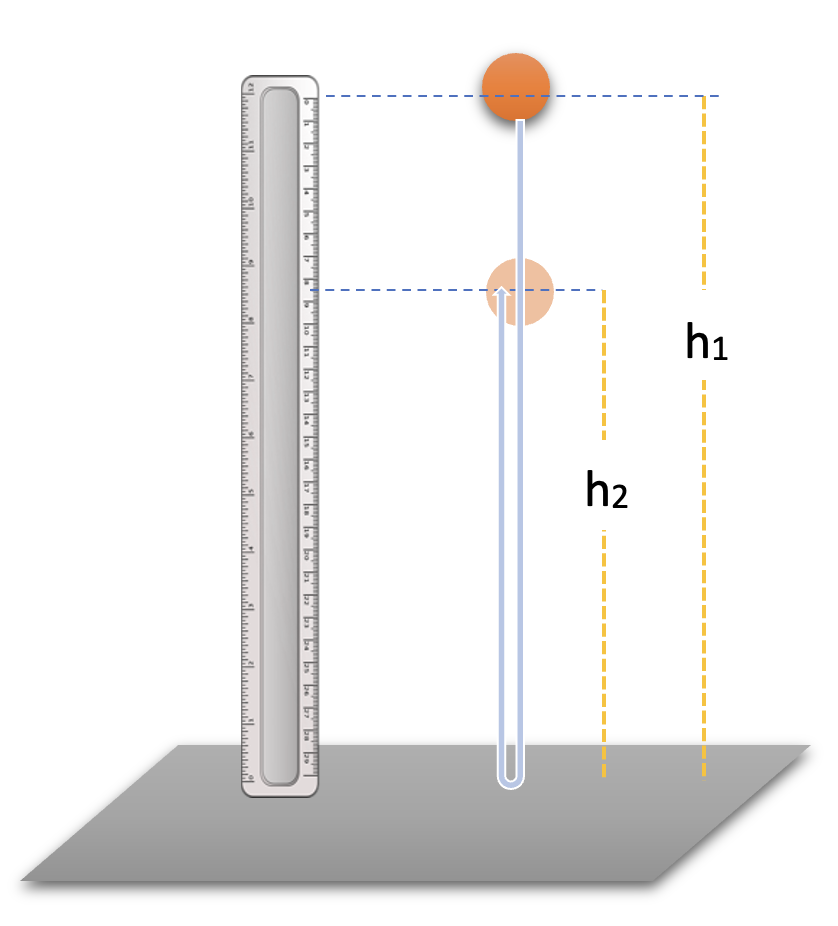To determine coefficient of restitution for inelastic collision
1. AIM
To determine the coefficient of restitution between different objects during inelastic collision by measuring the height of release and rebound.
2. APPARATUS USED
- Two spherical balls of different materials (e.g., rubber ball, tennis ball, steel ball, etc.)
- A smooth, hard, and flat surface (e.g., marble/granite slab or floor)
- Meter scale/measuring tape
- Clamp stand with clamp
- Graph paper
- Calculator
- Stopwatch (optional for alternative method)
- Plumb line and spirit level (to ensure surface is horizontal)
3. DIAGRAM

4. THEORY
When a ball is dropped from a certain height onto a surface, it undergoes an inelastic collision with the surface. The collision is characterized by some loss of kinetic energy, which means the ball won't rebound to its original height.
The coefficient of restitution (e) is a measure of the elasticity of the collision between two objects. It is defined as the ratio of the relative velocity of separation after collision to the relative velocity of approach before collision.
For a ball dropped onto a horizontal surface:
- If e = 1, the collision is perfectly elastic (no energy loss)
- If 0 < e < 1, the collision is inelastic (some energy loss)
- If e = 0, the collision is perfectly inelastic (maximum energy loss, no rebound)
When a ball is dropped from height h₁ and rebounds to height h₂, we can derive the coefficient of restitution using energy conservation principles.
5. FORMULA
When a ball falls from height h₁, its velocity just before impact is:
\[ v_1 = \sqrt{2gh_1} \]
After collision, its initial rebound velocity is:
\[ v_2 = \sqrt{2gh_2} \]
The coefficient of restitution is:
\[ e = \frac{v_2}{v_1} = \frac{\sqrt{2gh_2}}{\sqrt{2gh_1}} = \sqrt{\frac{h_2}{h_1}} \]
Therefore:
\[ e = \sqrt{\frac{h_2}{h_1}} \]
Where:
- e = coefficient of restitution
- h₁ = height from which the ball is dropped
- h₂ = height to which the ball rebounds
- g = acceleration due to gravity
6. PROCEDURE
- Place the flat surface horizontally. Use a spirit level to ensure it is perfectly horizontal.
- Set up the meter scale vertically next to the surface using the clamp stand.
- Take one of the balls and hold it at a measured height h₁ (e.g., 100 cm) above the horizontal surface.
- Release the ball (without giving it any push) and carefully observe the maximum height h₂ to which it rebounds.
- Repeat this process at least 5 times for the same height to get an average value.
- Repeat steps 3-5 for different heights of release (e.g., 80 cm, 60 cm, etc.).
- Repeat the entire experiment with another ball of different material.
- Record all observations in the observation table.
- Calculate the coefficient of restitution for each trial using the formula e = √(h₂/h₁).
- Calculate the average coefficient of restitution for each ball.
7. OBSERVATION TABLE
Table 1: Determination of Coefficient of Restitution for Ball 1 (Material: _______)
| Trial No. | Height of release, h₁ (cm) | Height of rebound, h₂ (cm) | Coefficient of restitution, e = √(h₂/h₁) |
|---|---|---|---|
| 1 | |||
| 2 | |||
| 3 | |||
| 4 | |||
| 5 | |||
| Average |
Table 2: Determination of Coefficient of Restitution for Ball 2 (Material: _______)
| Trial No. | Height of release, h₁ (cm) | Height of rebound, h₂ (cm) | Coefficient of restitution, e = √(h₂/h₁) |
|---|---|---|---|
| 1 | |||
| 2 | |||
| 3 | |||
| 4 | |||
| 5 | |||
| Average |
8. CALCULATIONS
Sample calculation for one trial:
Given:
- Height of release (h₁) = 100 cm
- Height of rebound (h₂) = 64 cm
Coefficient of restitution (e) = √(h₂/h₁)
\[ e = \sqrt{\frac{64}{100}} \]
\[ e = \sqrt{0.64} \]
\[ e = 0.8 \]
The average coefficient of restitution for each ball is calculated by taking the mean of all trial values.
9. RESULT
- The coefficient of restitution for Ball 1 (Material: _______) = _______ ± _______ (with uncertainty/error)
- The coefficient of restitution for Ball 2 (Material: _______) = _______ ± _______ (with uncertainty/error)
10. PRECAUTIONS
- Ensure the horizontal surface is completely flat and rigid.
- Release the ball without giving it any initial velocity (no pushing).
- Take readings from eye level to avoid parallax error.
- The ball should fall vertically without any spin or horizontal motion.
- Ensure there are no air currents that might affect the ball's motion.
- For accurate readings, the rebound height should be measured to the bottom of the ball.
- The surface should be clean and free from dust or impurities.
- Repeat each measurement multiple times to reduce random errors.
- Use balls that are perfectly spherical and uniform.
- Avoid surface dents or deformations that might affect the collision.
